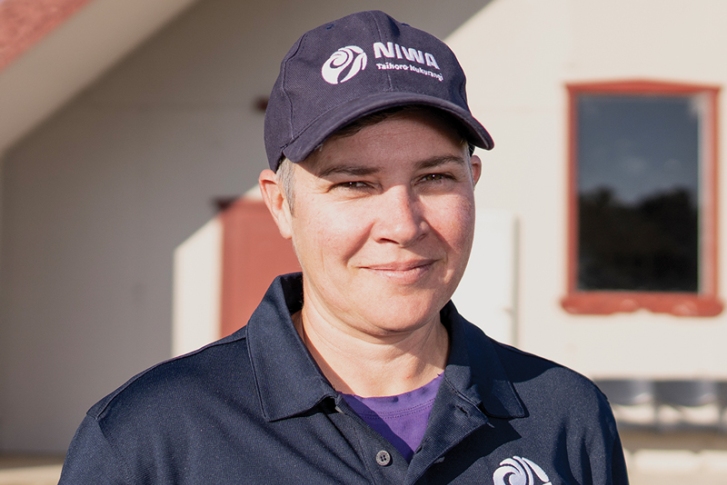NIWA is leading a new six-year research project that seeks to increase our understanding of piharau/kanakana/lamprey, using Mātauranga Māori, social science and biophysical science approaches.
Even though lamprey are an important customary fishery, very little is known about their biology and this research seeks to address a number of key knowledge gaps. The objectives of this research include (1) increasing our understanding of the historical abundance, distribution, timing of spawning migrations and the location of spawning and rearing areas; (2) determining when spawning migrations currently occur, the location of spawning sites, and the habitat associated with various freshwater life stages; (3) evaluating whether pheromones can be used to identify lamprey populations and spawning streams, and the ability of pheromones to attract lamprey to areas with depleted populations developing technologies to improve the upstream passage of adult lamprey; and (4) providing options to restore and enhance lamprey populations in Aotearoa.
The problem
Piharau/kanakana are an important taonga species and a prized delicacy for many Māori communities. In the past, lamprey were seasonally abundant in many New Zealand rivers and were at times taken in huge quantities. Very little scientific information has been collected across Aotearoa, partially because of the rarity and secretive nature of adults, as well as the lack of projects targeting this species.
Although adult lamprey spend extended periods of time in freshwater (up to 16 months) during their upstream migration to spawning grounds, lampreys are rarely seen, except where their migration is hindered or prevented by barriers. Little is known about the cues lamprey use for migration, and the habitats used during this extended period in freshwater.
It is anticipated that this research will investigate mātauranga Māori to identify historical baselines and the aspirations of Māori for the potential restoration of lamprey fisheries in Aotearoa.
Background
Unique lifecycle
Lamprey have a unique lifecycle and there are large gaps in our understanding about what they do at certain stages of it. If we want to restore and appropriately manage this fishery, we need to address these critical knowledge deficiencies.
Juvenile lamprey spend several years in freshwater before metamorphosing (changing colour and form) and migrating to sea. They come back into our freshwaters as adults and migrate upstream to particular areas to spawn, where the larvae hatch and grow into juvenile lamprey and the cycle continues (more information on each of these life stages can be seen in the "Fast Facts" tab).
Where do the adults go to spawn?
Although adult lamprey spend extended periods of time in freshwater (up to 16 months) during their upstream migration to spawning grounds, lampreys are rarely seen, except where their migration is hindered or prevented at obstructions. Little is known about the cues lamprey use for migration, and the habitats utilised during this extended period in freshwater.
The spawning grounds of Northern Hemisphere lamprey and their associated nests have been located and described, often with the help of telemetry studies. Telemetry studies using externally mounted radio tags were used in New Zealand to monitor the movements of lamprey in two South Island streams in the late 1990s. However, the maximum amount of time the tags were retained for was 56 days, which was not long enough to determine spawning sites.
This study seeks to build on the initial telemetry work by using Passive Integrated Transponders (PIT) to improve our understanding of the behaviour of pre-spawning adult lampreys in our freshwaters, and to attempt to locate spawning sites.
The solution
Could we use their amazing sense of smell?
In the Northern hemisphere, adult lamprey have been shown to select spawning streams based on a migratory pheromone mixture released by larvae living upstream. In addition, mature female lampreys will also select streams based on the sex pheromone released by mature males.
Dr Cindy Baker has shown that certain pheromones are released by New Zealand larval lamprey and has been developing a method for finding some of these compounds in stream water, with the aim of providing a tool in the future that can identify streams with high numbers of larval lamprey. Future research will also see if we can use pheromones to attract adult lamprey back to specific areas.
Customary fishers
NIWA would greatly appreciate the involvement of Māori piharau/kanakana fishers to interview and gain a better understanding of this important customary fishery. With the permission of interviewees, we will use the information to build a picture of the abundance (past and present) and distribution of this taonga species. All interviews will be recorded, transcribed and then returned to the person who contributed it. This information will be collated into a report for all of the contributors. Any information collected from these interviews will be used for the purposes of this kaupapa only, and will not be identifiable by person's name (unless people would like to be identified).
In future we may seek permission from each contributor to present and/or publish this important information: please be assured that this will not occur without interviewees' knowledge and expressed permission. If you would like to be involved and be interviewed as part of this kaupapa, please contact Mr Weno Iti or Mrs Mandy Home. If you wouldn't like to be involved, but would like to be informed of the outcomes of this research as they occur please contact Weno or Mandy and they will add you to our contacts list.
The result
Spawning habitat
This research has been successfully tracking close to 100 pre-spawning lamprey adults in the Okuti River catchment. The approach is providing essential insights into the habitat requirements of this life stage during their freshwater spawning migrations.
To date, the field results have shown that the upriver spawning migration of adult lamprey is closely linked with increased river flows. The lamprey are migrating mainly at night but are not strictly nocturnal, as close to 30% of detected migrations occurred during the day. Of the monitored fish, the majority of lamprey have chosen to migrate up the major river within the catchment (74%), with only 26% of fish selecting the smaller tributary stream. The micro-habitats used by lamprey during this migration have also been identified.
This knowledge is fundamental to the rehabilitation and restoration of lamprey populations and has important implications for ensuring lamprey populations are retained within rivers and streams that water is removed from for other purposes.
Pheromones
We have been developing in-stream passive samplers to quantify migratory pheromones as a population monitoring tool for lamprey populations. This tool will enable customary fishery managers and researchers to quickly and cost-effectively determine the distribution of lamprey within an area.
To date these tools have been applied to assess concentrations of lamprey pheromones from three New Zealand streams known to have historic and current populations of Geotria australis ammocoetes (larvae). Auckland Council have also utilised the in-stream samplers to investigate lamprey densities in selected Auckland waterways.
The analytical methods we have developed in New Zealand for detecting larval lamprey pheromones in water samples has attracted international interest. These international linkages will continue to increase our ability to develop unique approaches to restore and enhance this taonga species.
Fast facts
Below are some of the known facts about each part of the lifecycle of a lamprey.
1. Ammocoetes - larval/juvenile lamprey
Length: up to about 80-100 mm (smallest found to date were 11 mm long).
Colour: brown-grey.
Key features: no eyes yet, and a hood over the mouth.
Kai: filter algae and small bits and pieces from the water.
Live in: freshwater. They burrow into the mud or sand in shallo water (less than 0.3 m deep) in places with overhead shade. Ammocoetes hide during the day, and possibly come out at night. This stage of the lifecycle lasts about 3-5 years.
2. Macrophthalmia - juvenile lamprey
Length: while juveniles in freshwater, about 80-120 mm long.
Colour: brilliant silver-blue.
Key features: this stage is silver with thin blue stripes along the back and large silver eyes. The fins get larger and teeth develop.
Kai: juvenile lamprey are parasitic. When they reach the ocean, they latch on to fish with their sucker-like mouths, and feed off the fish.
Live in: as they change colour from brown to blue, they move downstream in July and August to the ocean. They spend about 3-5 years there, feeding and growing to about 450-750 mm long.
3. Adult lamprey, fresh sea run
Length: about 450-750 mm long.
Colour: silver-blue when first arrive in ocean waters from freshwater.
Key features: have two 'eletric' blue-green bands along the side of their body.
Kai: the adults stop feeding once they come back into freshwater.
Live in: after about 3-5 years in the ocean, adult lamprey enter freshwaters during winter and spring. They move upstream at night, hiding during the day. At this stage their gonads (reproductive organs) are undeveloped.
4. Mature adult lamprey
Length: about 600 mm long.
Colour: brown
Key features: males grow a pouch behind the mouth. They lose weight and get shorter as they get older.
Kai: Adults stop eating once they return to freshwater. They use their reserves of fat for energy.
Live in: freshwater. Although it has never been observed, they are likely to spawn into small forested streams with gravel and overhead cover. Adults die after spawning.
Read more: Kanakana: Sniffing out a place to spawn (PDF 9MB)
References:
Empson, P. W., Meredith, A. S. (1987). Downstream migration of Geotria australis juveniles in the lower Waikato River (Note). New Zealand Journal of Marine and Freshwater Research 21: 643-644.
James, A. (2008). Ecology of the New Zealand Lamprey (Geotria australis): A literature review. Department of Conservation, Whanganui: 28 p.
Jellyman, D. J. (2009). A review of radio and acoustic telemetry studies of freshwater fish in New Zealand. Marine and Freshwater Research 60: 321-327. http://www.publish.csiro.au/paper/MF08112
Jellyman, D. J., Baker, C. F. (2006). Lampreys run at Monowai. Water & Atmosphere 14(4): 4. http://www.niwa.co.nz/news-and-publications/publications/all/wa/14-4/ne…
Jellyman, D., Robertson, M. (1997). Lampreys on the move. Water & Atmosphere 5(4): 5.
Jellyman, D. J., Glova, G. J. (2002). Habitat use by juvenile lampreys (Geotria australis) in a large New Zealand river. New Zealand Journal of Marine and Freshwater Research 36: 503-510.
Jellyman, D. J., Glova, G. J., Sykes, J. R. E. (2002). Movements and habitats of adult lamprey (Geotria australis) in two New Zealand waterways. New Zealand Journal of Marine and Freshwater Research 36: 53-65.
Kelso, J. R. M., Glova, G. J. (1993). Distribution, upstream migration and habitat selection of maturing lampreys, Geotria australis, in Pigeon Bay Stream, New Zealand. Australian Journal of Marine and Freshwater Research 44: 749-759. http://www.publish.csiro.au/paper/MF9930749
Kelso, J. R. M., Todd, P. R. (1993). Instream size segregation and density of Geotria australis ammocoetes in two New Zealand streams. Ecology of Freshwater Fish 2: 108-115. http://onlinelibrary.wiley.com/doi/10.1111/j.1600-0633.1993.tb00090.x/a…
McDowall, R. M. (2011). Ikawai: Freshwater fishes in Māori culture and economy. Christchurch, N.Z., Canterbury University Press. 872 p.
Stewart, M., Baker, C., Cooney, T. (2010). The development of a high sensitive and selective method for detection of Lamprey Migratory Pheromones in rivers. Presented to " Freshwater Solutions: Going beyond the problem", New Zealand Freshwater Sciences Society Annual Conference. 22-26 November 2010, Christchurch, New Zealand.
Stewart, M.; Baker, C. (2012). A sensitive analytical method for quantifying petromyzonol sulfate in water as a potential tool for population monitoring of the southern pouched lamprey, Geotria australis, in New Zealand streams. Journal of Chemical Ecology, 38: 135-144.
Stewart, M.; Baker, C.; Cooney, T. (2011). A rapid, sensitive, and selective method for quantitation of lamprey migratory pheromones in river water. Journal of Chemical Ecology, 37: 1203-1207.
Todd, P. R., Kelso, J. R. M. (1993). Distribution, growth and transformation timing of larval Geotria australis in New Zealand. Ecology of Freshwater Fish 2: 99-107. http://onlinelibrary.wiley.com/doi/10.1111/j.1600-0633.1993.tb00089.x/a…









